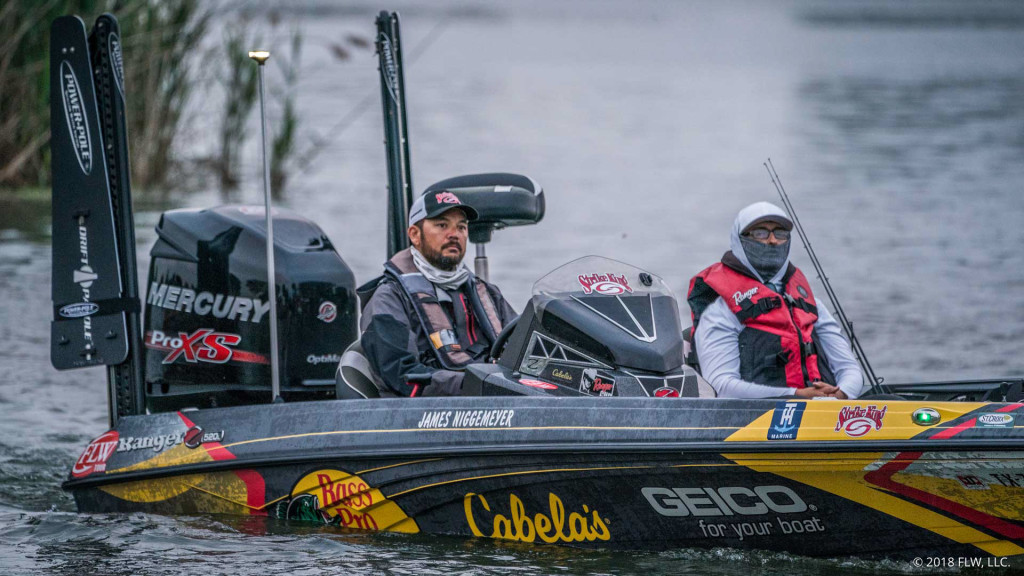Create a Base List of Go-To Baits
It's tackle-prep season for Niggemeyer

Nov. 1 was kind of a wake-up call for me. It’s the day I realized the 2019 FLW Tour season was bearing down on me fast, with so much still to do to get ready.
I’m working hard to catch up. My new Ranger and Mercury FourStroke are on the way and should be ready any day now. I’ll need to drop in some Cabela’s X-900 batteries and finish out the rigging. I just wrapped up filming with Strike King, and I’m finishing up work agreements with some sponsors for the upcoming season. Plus, I’ll be running guide trips over the next couple months.
All those things are business as usual for a touring pro in the offseason, and none of it really rattles me too much. I enjoy it all, in fact.
What I don’t enjoy, however, and what has me feeling a bit rushed for the upcoming season is the biggest chore of all: Somehow, I have to comb through and organize the heap of tackle sitting on my garage floor.
Terrible, right?
It sort of feels that way to me. Every season, my garage goes from organized to absolute chaos as I come and go from one tournament to the next. By the time I empty out my boat in the fall to sell it, I wind up with a mountain of tackle that needs to be dealt with. It needs to be culled, cleaned up, organized, re-stocked or replaced so it can be packed into my new boat, organized in the garage or stowed in my truck bed camper, keeping in mind all the lakes and reservoirs the FLW Tour will be visiting from January through August.
This is the time that I rebuild some sanity in my garage workspace, and it’s kind of a scary project. Hopefully, my methods can help provide a working plan for anyone else dealing with a similarly daunting tackle organization project.
I like to start on the ground level with the basic stuff I can’t live without. I call it my base kit: spinnerbaits, square-bill crankbaits, lipless crankbaits, bladed jigs and tons of soft plastics ranging from soft stick baits to creature baits. These are the baits that, as a shallow-water power-fisherman, fall directly into my wheelhouse. They’re my basic toolbox baits that I might throw at any and every stop along the FLW Tour trail. I never dump the boat in without them.
From there, I start to piece together small boxes of more specialized tackle: deep-diving crankbaits and other ledge-fishing baits for the Tennessee River, finesse options for the Great Lakes, small swimbaits for clear-water reservoirs and some cool West Coast-centric stuff I learned to use when I was growing up in California that comes into play every now and then. These are the boxes that get shifted in and out of the boat throughout the season based on where I’m headed.
Terminal tackle gets divvied up similarly in order to keep the weight manageable in each box. I have one box with a bunch of hooks for different types of Texas-rigging, weights up to 2 ounces and accessory items such as bobber stops. Another box stores gear for common rigs such as drop-shots and Carolina rigs. I keep a small box handy with shaky heads and wacky-rig tackle – a lot of little stuff – and another filled with jointed, wobble-type jigheads.
As I piece together my tackle, I sometimes have to make tough decisions about what gets cut. There are some things I’m confident in that I only throw from time to time, maybe only once every couple years, but when I do I’m so glad I have them. Other items that maybe I thought were going to be great that never really worked get pitched.
My process of organizing tackle is constantly being refined, yet you might be surprised to know that my overall collection doesn’t vary too much from year to year.
One lesson I’ve learned in my career is that the best way to win or place high in a tournament is to stick to my strengths whenever possible, and to focus on doing what I’m comfortable with and do best.
Sure, I experiment with new baits and try to learn new skills every year. But quite often those additions wind up being put to use in only small windows of opportunity – one fish here, or one bailout, backup plan there. The rest of the time, I stick with the baits and the skills I know.
One last piece of advice if you’re climbing your own mountain of tackle is to try to do your tackle shopping before the season begins so you can avoid visiting the tackle shop when you get to a tournament. If I have to visit a tackle shop while I’m on the road, it’s because I didn’t prepare enough beforehand, or I ran out of something. Local tackle shops are great places to find new, regionally liked items, and you’re going to see some stuff you don’t see at home. The problem is, you inevitably spend money on stuff you don’t need or won’t use again.
Save the cash for the tackle you know you use or for more entry fees, and maybe in the process you’ll keep the offseason tackle mound to a manageable size.
Follow James Niggemeyer’s career, and learn more about his guide operation, at JamesNiggemeyer.com.